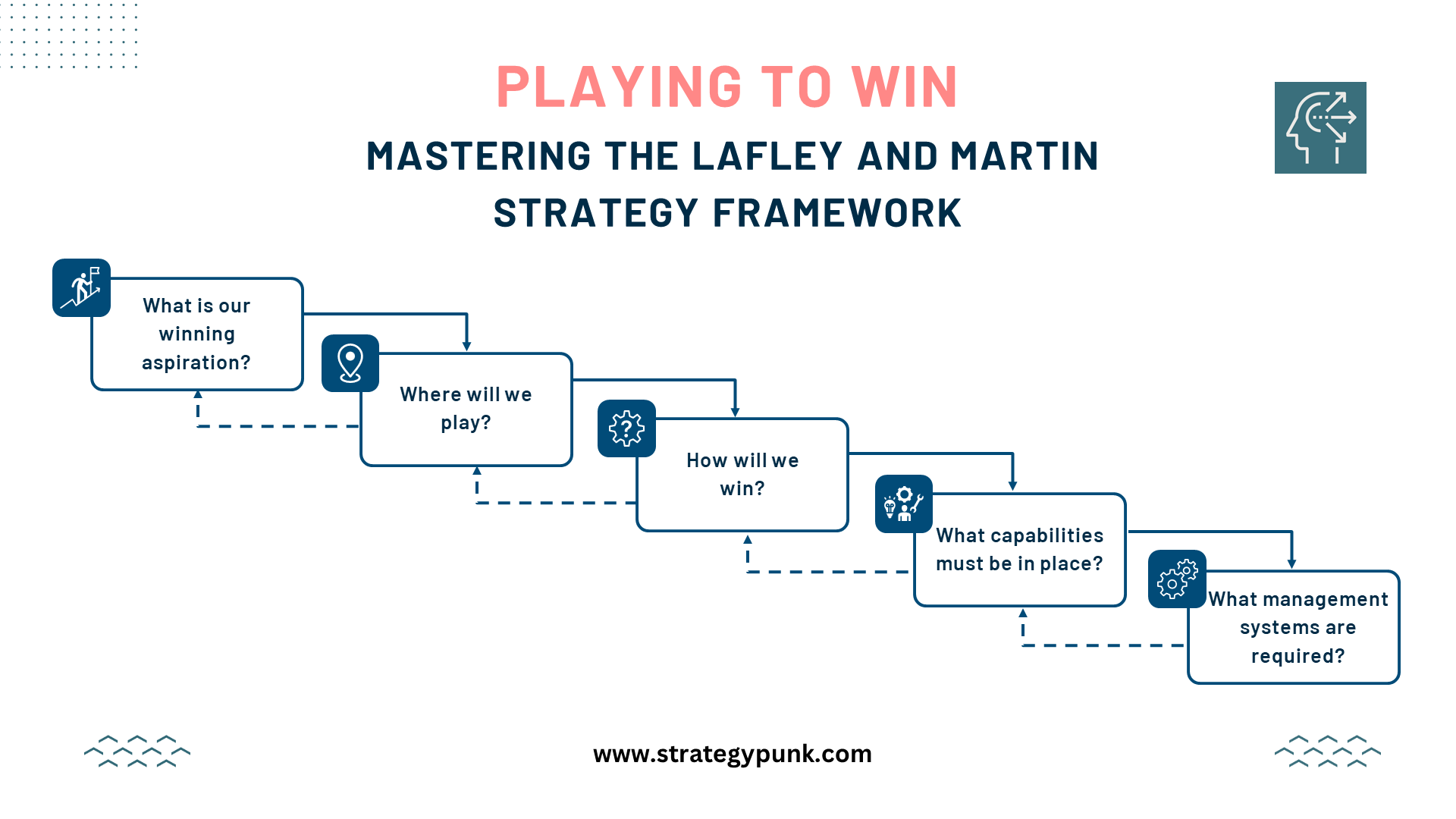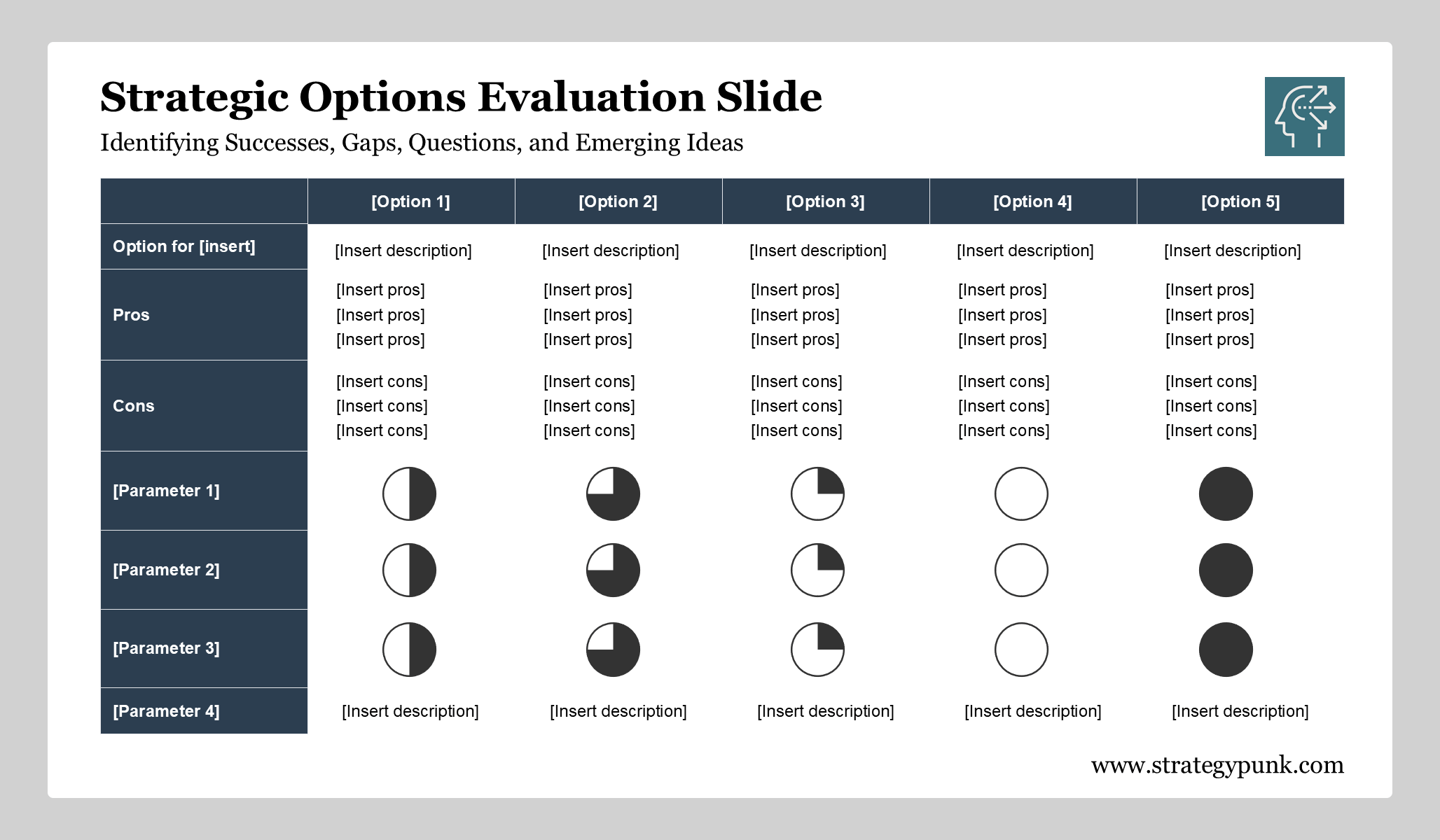Playing To Win: Mastering the Lafley and Martin Strategy Framework
Master strategic planning with the 'Playing to Win' framework. Outshine competitors and achieve ambitious goals using A.G. Lafley and Roger Martin's robust roadmap. Perfect for startups, established businesses, and beyond!

Effective strategic planning is more critical than ever in today's competitive business landscape.
Guiding us through this complex process, A.G. Lafley and Roger Martin's "Playing to Win" strategy framework provides a clear, robust roadmap to ensure your organization thrives.
The Five Pillars of the Playing to Win Framework
- Winning Aspiration: Every business needs to set a clear, inspiring vision of its end goal. This goal could be anything from becoming the market leader to innovating a groundbreaking product.
- Where to Play: Next, you must decide where to focus your efforts. This is about selecting the most suitable market segments, customer demographics, or geographical areas where your organization will compete.
- How to Win: With a chosen playing field, you need a game plan. This entails crafting a compelling value proposition that distinguishes you from competitors and highlights what makes you unique or better.
- Core Capabilities: Winning requires specific essential skills or assets. These core capabilities - superior customer service, advanced technology, or unparalleled expertise - allow your organization to execute its winning strategy effectively.
- Management Systems: Lastly, you need systems that support your strategy and measure its success. These systems keep you on track, ensuring you're moving in the right direction and adjusting course when needed.
Applying the "Playing to Win" Strategy: A Hypothetical Scenario
Let's consider a hypothetical tech firm, "TechPro," to illustrate how the "Playing to Win" framework is implemented.
TechPro aspires to become the preferred provider of cybersecurity solutions for small businesses—a clear "Winning Aspiration" within the "Playing to Win" framework. They decided to target small businesses in the U.S. market that lack robust IT departments, defining their "Where to Play."
For the "How to Win" step in its "Playing to Win" strategy, TechPro develops a unique, user-friendly cybersecurity software suite. It invests in its "Core Capabilities" by focusing on exceptional customer service and user education.
Finally, TechPro builds a comprehensive monitoring system to track progress and gather customer feedback.
Using the "Playing to Win" framework, TechPro successfully positions itself as the leading cybersecurity solution provider for small businesses.
The "Playing to Win" strategy is a tried-and-tested roadmap to success. It offers a systematic approach to strategic planning and is a game-changer for any organization aiming to outshine competitors and achieve ambitious goals.
Applying the "Playing to Win" Strategy Outside The Realm Of Business
The "Playing to Win" strategy can be related to various scenarios, even outside the business.
Let's explore two examples - one from sports and another from the art of cooking.
Example 1: Sports - A Basketball Team
- Winning Aspiration: The team's aspiration might be to win the national championship. This goal aligns all their strategies and efforts.
- Where to Play: This could refer to the team's style of play. They may excel in fast-paced games, focusing on scoring points through rapid breaks, or they may shine in slow, defensive play.
- How to Win: They employ these tactics to outmaneuver their opponents. This could involve creating unique offensive plays, focusing on 3-point shots, or building a rigid defensive wall to penetrate.
- Core Capabilities: To win, the team must build speed, agility, shooting accuracy, defensive ability, and even exceptional team chemistry.
- Management Systems: Finally, the team's coaching staff needs to establish methods for monitoring players' performance, tracking progress toward their goal, and adjusting strategies based on each game's outcome.
Example 2: Cooking - Mastering a Signature Dish
- Winning Aspiration: A chef might aspire to create a signature dish that is unique and loved by customers.
- Where to Play: The chef focuses on a cuisine that matches their culinary skills and passion, like Italian cuisine.
- How to Win: The chef experiments with ingredients and techniques to create a dish that stands out, like a spaghetti recipe with a unique blend of spices.
- Core Capabilities: To create their signature spaghetti, the chef must enhance their cooking skills, learn about various spices, and perfect their sauce-making technique.
- Management Systems: The chef would need to ensure the dish's consistency, monitor customer feedback, and adjust the recipe or preparation process based on this feedback.
These analogies show that the "Playing to Win" strategy can be applied to nearly any scenario where there's a goal and competition - whether you're in a sports team aiming for a championship, a chef seeking to create a standout dish, or a business aiming to outperform in the market.
Thought-provoking questions related to the "Playing to Win" Strategy Framework
Formulating questions that promote deeper thinking and curiosity is vital to learning and teaching.
Here are some thought-provoking questions related to the "Playing to Win" strategy:
Understanding the Framework
- How does the "Winning Aspiration" influence the rest of the strategy?
- Why is the decision on "Where to Play" critical for the success of a business?
- Can you explain the interplay between "Where to Play" and "How to Win"?
- How does a company identify its "Core Capabilities"?
- Why are "Management Systems" necessary even after defining the other four steps?
Applying the Framework
- How would you apply the "Playing to Win" strategy to a startup company? What about a well-established corporation?
- Can the "Playing to Win" framework be applied to non-profit organizations or public institutions? How?
- How would the "Playing to Win" strategy change in technology, fashion, or food service industries?
Analyzing Real-world Cases
- Can you identify a company that has effectively used the "Playing to Win" strategy?
- How might a company have failed by not adequately defining its "Winning Aspiration" or knowing "Where to Play"?
- Can you find examples of organizations that transformed their "Core Capabilities" to win?
Exploring Further
- How does the "Playing to Win" strategy align or conflict with other business strategies you know?
- In what ways might the "Playing to Win" strategy need to evolve in the face of rapid technological advancements or market changes?
- How can ethics and social responsibility fit into the "Playing to Win" strategy?
Remember, the goal of these questions isn't to quiz for right or wrong answers but to stimulate deep thinking, promote curiosity, and encourage exploration of the "Playing to Win" strategy from various perspectives.
Breaking down a complex framework like "Playing to Win" into smaller, manageable chunks is a great way to facilitate understanding and mastery. Let's focus on each step in a structured manner.
Breaking down the "Playing to Win" strategy process into its key components
Indeed, breaking down a complex framework like "Playing to Win" into smaller, manageable chunks is a great way to facilitate understanding and mastery. Let's focus on each step in a structured manner.
Winning Aspiration
- Understand the Concept: Start by reading articles, blogs, or case studies to understand the concept of "Winning Aspiration." This step sets the vision for the entire strategy.
- Practice: Formulate a winning aspiration for a hypothetical business. It could be anything from becoming a market leader to creating an innovative product.
- Review: Assess the aspiration you've created. Is it inspiring? Is it challenging yet attainable? Would it give clear direction to the entire organization?
Where to Play
- Understand the Concept: Dive into resources explaining this step, including its importance and how it fits into the strategy.
- Practice: Based on the winning aspiration you formulated, decide on a specific market segment, geographical area, or demographic to target.
- Review: Evaluate your choice. Is it the most suitable given your aspiration? Are there other areas you could consider?
How to Win
- Understand the Concept: Study the importance of the value proposition in the "Playing to Win" strategy.
- Practice: Develop a unique value proposition for your hypothetical business that could set it apart.
- Review: Reflect on your proposition. Is it compelling? Does it offer something unique to your chosen market?
Core Capabilities
- Understand the Concept: Explore what core capabilities mean and why they are crucial in the strategy.
- Practice: Identify the skills or assets your hypothetical business would need to execute its strategy effectively.
- Review: Consider if these capabilities are sufficient and relevant. How would they give your business an edge?
Management Systems
- Understand the Concept: Understand the role of systems in supporting the strategy and tracking progress.
- Practice: Design a simple system that could measure your hypothetical business's success and guide it towards its winning aspiration.
- Review: Reflect on your system. Is it practical? Would it provide helpful feedback for strategy adjustment?
Remember, mastering each step in the "Playing to Win" strategy takes time. Take your time with the stages. Take the time to understand, practice, and review each step thoroughly.
Gradually, you'll find that you can effectively apply this robust framework, whether planning a business strategy or teaching it to others.
Executive Summary
- "Playing to Win" is a strategic framework by A.G. Lafley and Roger Martin for navigating the competitive business landscape.
- Five pillars of this strategy framework include:
- Winning Aspiration: Setting a clear, inspiring vision or end goal for the organization.
- Where to Play: Choosing the most suitable market segments, demographics, or areas for competition.
- How to Win: Crafting a unique value proposition to set the organization apart from competitors.
- Core Capabilities: Identifying essential skills or assets for executing the winning strategy.
- Management Systems: Implementing systems to support strategy and measure its success.
- Applying this strategy to a hypothetical tech firm, TechPro, resulted in successful positioning as the leading cybersecurity solution provider for small businesses.
- The "Playing to Win" strategy is not confined to business alone. It can be applied to various scenarios, such as a basketball team's strategies or a chef mastering a signature dish.
- Thought-provoking questions can enhance understanding and curiosity about this strategy, ranging from understanding the framework to analyzing real-world cases.
- The "Playing to Win" strategy can be mastered by breaking it down into manageable chunks: Understand the concept, Practice, and Review each step.
- Each step should be thoroughly understood, practiced, and reviewed over time to apply the framework in strategic planning or teaching effectively.
"Playing To Win" Strategy PDF Template
Elevate your strategic planning with our 'Playing to Win' Strategy PDF Template.
Designed to guide you through each step of this potent framework, our template ensures you're not just participating - you're Playing to Win!






